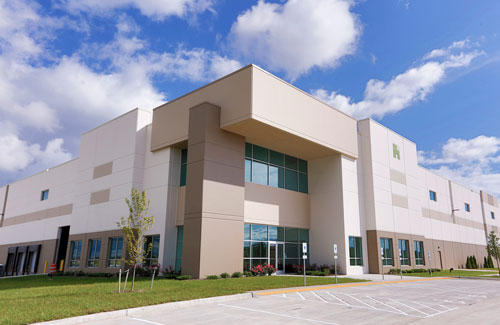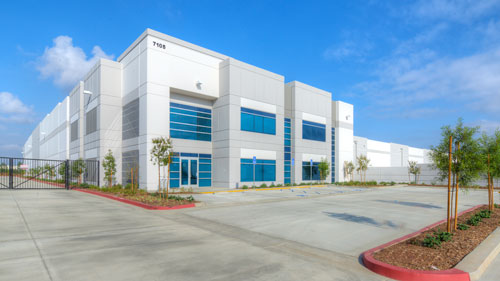CEO Peter Baccile left investment banking for First Industrial Realty Trust at a promising time for industrial REITs.
When talking about his move from investment banking to the C-suite of a publicly traded REIT, Peter Baccile invokes one of his mother-in-law’s favorite sayings:
“You have to take the cookies when they are passed.”
After three decades with some of the world’s foremost investment banks, Baccile says he jumped on the opportunity to become president of First Industrial Realty Trust (NYSE: FR) in September of 2016. A few months later, as planned, he added CEO to his nameplate when Bruce Duncan retired from the CEO position of First Industrial’s board of directors.
The offer to join Chicago-based First Industrial came at an opportune time personally, according to Baccile, with his youngest child preparing to leave for college. More importantly, though, he says he wanted to be part of a company that he had come to admire during his banking career.
“First and foremost, it was such a fantastic and rare opportunity to join a company I’ve known and respected for a long time,” he says. “My wife is excited about our new adventure in Chicago as empty nesters, and we have already taken advantage of many of the wonderful dining, cultural and entertainment options available here.”
In an interview with REIT magazine, Baccile discussed the recent influx of bankers into REIT management teams, his first year on the job and what he calls the “golden age of industrial real estate.”
When I first met you, you were at J.P. Morgan. You later moved on to UBS in 2012. In total, you spent 30 years as an investment banker. So many in and around the real estate business knew you as a banker. Do you think it caught people off-guard when they found out you were leaving for an executive position at a REIT?
Clearly, I loved my time in the banking industry as I called it home for virtually my entire working life. So, I am sure a few of my clients, colleagues and friends may have been mildly surprised with my move.
You will recall that the business changed dramatically during the 1990s as capital formation boomed in both the public and private markets. It was during that time period and into the early 2000s that the management and funding of real estate became more corporate and more sophisticated than it had ever been before. I very much enjoyed working with talented management teams on capital and operating strategy, M&A, and new growth strategies.
So, I felt well prepared coming into this new role and view my move to the operating side and joining First Industrial as CEO as a natural extension of the skills and experiences I gained during my banking career.
What was it about First Industrial and the opportunity there that made you want to make that kind of move?
I knew the company well from serving as a banking partner, working with Bruce Duncan, our chairman, and the senior management team very closely over many years. I experienced firsthand how the company fixed and strengthened its balance sheet.
I had a great appreciation for the company’s national portfolio, its platform and ability to create value through development, acquisitions, and leasing. I was impressed by the people—their tenure, their accomplishments, and their passion for our company and our business.
While that was certainly more than enough, we are in what I consider to be the “golden age of industrial real estate.” There is much opportunity ahead to grow cash flow and value. The growth in e-commerce and its impact on the global supply chain has been and will continue to be profound, and it’s a story that is still in the early chapters.
We’ve actually seen a few other bankers joining REIT management teams in recent years. Is that coincidental, or do you think that boards find something about that particular skill set attractive in the current real estate landscape?

Capital is the lifeblood of the real estate industry, so as a banker, one would hope to be well-versed in the capital markets.
But it’s also the entire array of business skills that are required to successfully lead a banking group that are just as critical and applicable to a publicly traded real estate company: anticipating and meeting the needs of customers; identifying key trends; driving profitable growth; allocating capital to the right opportunities; developing lasting relationships; and working together with and motivating a team of talented professionals to achieve our goals and mission.
Bankers also have a good understanding of operating in the public domain.
What has been the hardest part of the transition?
There is a lot to learn in a short period of time. In the first six months, I visited with all of our market teams across the country and toured the vast majority of our 62 million square feet of assets. We have 500-plus properties and 1,300 tenants, so there are a lot of strengths and opportunities you need to understand. You develop a stronger sense of what drives tenant interest in certain submarkets versus other alternatives.
At the same time, you need to be on top of major personnel decisions, capital allocation and normal-course public company requirements. In addition, you need to be developing relationships with all the major stakeholders of the company. You learn to create a routine pretty quickly.
The other thing I realized early on is just how difficult it is to bring a new project to fruition in this extremely competitive market. The skill and patience of our team in working with our development partners, as well as government and regulatory agencies, to see projects from start to finish is an underappreciated art. In part, it also explains why new supply in industrial has been measured despite strong growth in demand over the past several years.
What was your top priority when you took over as CEO in 2016?
Get out and see our people, our properties, our markets and our customers’ businesses. I’ve always believed that any good leader knows the details of his or her business. The details make all the difference.
Everybody in real estate knows the importance of location. In the industrial business, our world is evolving rapidly. The needs of our tenants are changing almost weekly, so offering the right form and functionality to our tenants is an area where we must stay on top of the trends.
Not only that, but having professional property managers that are responsive to our customers and take care of our buildings is key to retention, especially in a down market. Customer service is ingrained in our culture, and it shows as we ranked number one in the independent Kingsley Index for industrial real estate providers reporting more than 30 million square feet.
We talk about it all the time. We are building and managing our business to perform well through the cycle. Bad times will come; we can do a lot now to ensure we perform well during those times.
It seems as though industrial and logistics real estate sits at the nexus of some of the top innovations and disruptions now affecting the global economy. What does that mean for your ability to strategize for the long term?
We have to be in constant communication with our clients. As I mentioned earlier, we have to stay ahead of the trend line for the form and functionality they require in their spaces. It’s changing and there are many factors that influence the functionality our clients will require.
Robotics, the availability of labor, the use required for that space—distribution, returns, same-day delivery, et cetera. We continually discuss these and other factors with our clients.

We also focus on consumption zones. Where are the people? Where are sales growing the fastest? Where is the wealth? Where is the population growing? It’s not that different from the way a mall developer would look at population and wealth demographics around a potential new project location.
So, it’s important for us to locate our buildings in markets where the demographics are strong, but also where they will be strong over the coming years.
What do you think will be the key issue that industrial real estate companies will face over the next decade?
The industrial supply chain is in a constant state of motion, accelerated by the force of e-commerce. What happens to that supply chain as distribution technology evolves and companies retool and retrench to compete are essential to our business. We need to be in touch with our customers and be ahead of these trends with respect to building and site design, size, features and locations.
And how far afield will we go to accommodate the needs of our e-commerce tenants? The more special purpose the use, the higher the risk on that asset.
What about the investors evaluating these companies? What should they be considering?
There are a wide range of factors one can consider, but as a company, we believe the best thing for us to focus on delivering for investors is long-term cash flow growth and value creation. They should want companies with well-located properties that are positioned to compete through the cycle and that can deliver above-average rental rate growth and total returns. They should also look at a company’s ability to to use its platform to create value through development and value-add investing in the context of proper risk management: Again, long-term performance through the cycle.